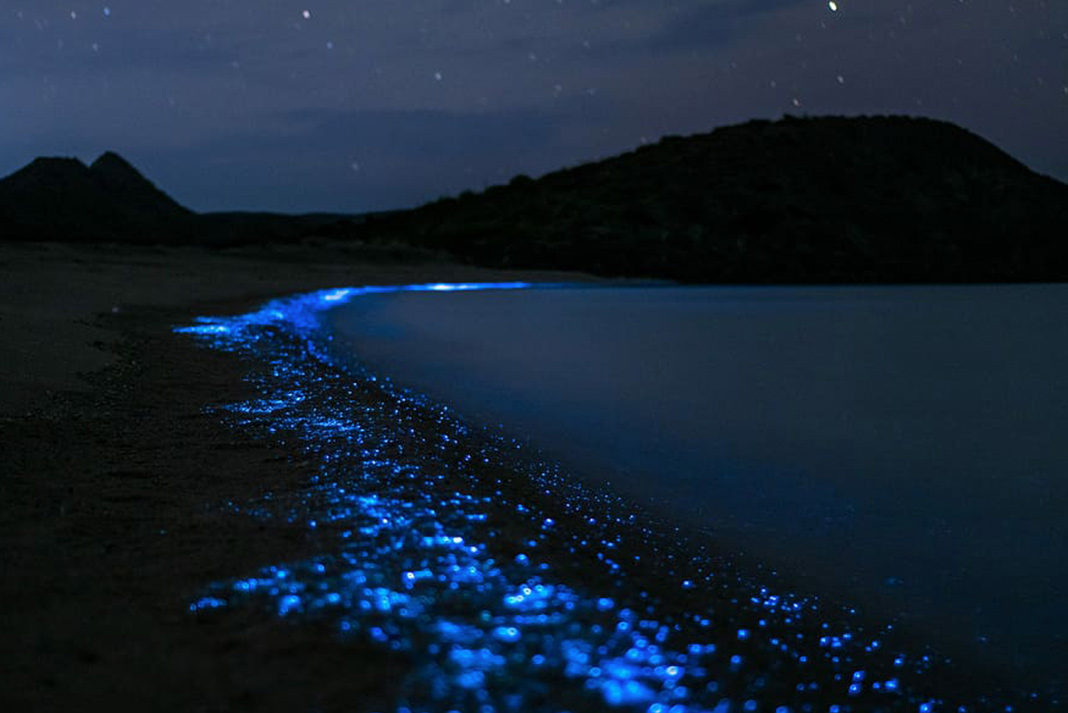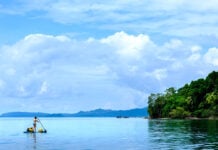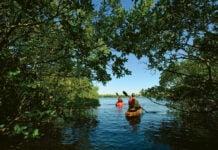Bioluminescence is a unique wonder that thrills almost everyone. Whether it’s created by a land-based creature like a firefly, or marine life like jellyfish or algae, we all gaze in wonder at the natural light shows they create.
Marine-based micro-organisms that create their own light are particularly magical, setting ocean waters aglow at night. These organisms are known as dinoflagellates—don’t worry, they don’t carry toxins and won’t harm you. These tiny, glowing plankton live in water columns in oceans across the globe, thriving in the invisible vertical ribbons that run from the seabed to the surface of the ocean.
When disturbed by motion around them, dinoflagellates emit a blue-green glow. This is why kayaking is one of the best ways to witness this wonder—when you dip your paddle into the sea, or the hull of your kayak glides forward through the water, these dinoflagellates sense the motion and fill the surrounding water with an ethereal glow.
Bioluminescence isn’t something scientists entirely understand, which makes it all the more intriguing. We do know that the chemistry behind the glow of bioluminescent organisms is very similar to that of an ordinary glowstick, which means it fades over time. While a traditional lightbulb produces incandescent light, which is warm, bioluminescent organisms produce luminescent light, which does not emit heat.
One reason for our lack of knowledge is that scientists have limited windows to study these animals because they do not produce a constant source of light. As well, in some cases, disturbing the organism enough to contain it for study can damage it. If you’re looking for more information on these unique creatures, Stuff You Should Know podcast has a thoroughly informative episode from a few years ago on the topic of bioluminescence.
From a paddler’s perspective, bioluminescent kayaking is an unforgettable experience that will leave even the most well-traveled among us grinning with wonder.

Best places to go bioluminescent kayaking
Florida
Summers in Florida are the prime season for seeing the “milky sea” phenomenon at night, and there are a few places that boast the best bioluminescent kayaking. About an hour drive from Orlando, you’ll find two popular coastal towns: Cocoa Beach and Titusville. Both of these are popular launch spots for bioluminescent kayaking tours in Florida.
If your tour company offers it and it’s within your budget, an amazing option to keep in mind is bioluminescent kayaking with a clear kayak. Being surrounded by the dinoflagellates’ gentle blue-green glow as you move through the ocean will only add to the otherworldliness of your adventure! Many tour companies offer this as an upgrade to their bioluminescent kayaking tours and some only offer clear kayak tours.
On the gulf side, the Tampa area offers beautiful bioluminescent kayaking experiences. This area is not only rich in glowing seas during the summer months, it’s also home to a huge array of marine biodiversity like dolphins, rays, and manatees among many other interesting creatures.
BK Adventures
- Regular kayak: $55 per person
- Clear kayak: $72 per person
See Through Adventures
- $89 per person, clear kayaks only
Florida Eco-Adventures
- $35 per person, summer only
Puerto Rico
Puerto Rico is a bioluminescent paradise! Because dinoflagellates are so tiny, there needs to be a very dense concentration of them for you to be able to see their glow. There are only five locations in the world with enough dinoflagellates to be considered bioluminescent bays, or “bio bays.” Puerto Rico is home to three of them: Mosquito Bay, Laguna Grande (commonly referred to as Bio Bay), and La Parguera. Discover Puerto Rico is a great resource for more information on the bioluminescent ecosystem in Puerto Rico. Better yet, Puerto Ricos’ waters are aglow with dinoflagellates year-round.
Moonlight is an element to keep in mind when you’re bioluminescent kayaking. While you can still see the glow of dinoflagellates when the moon is more full, the darker the night, the more you’ll see. Bio Bay Fajardo has a good page that goes over how to plan for moonlight on your kayak tour.
Puerto Rico Bio Bay Tours
- $55 per person
Yokahú Kayak
- $48 per person
Eco Adventures
- $48 per person
Tomales Bay
Tomales Bay is a secluded spot in Northern California that’s home to famously good oysters, vacation-worthy inns, hotels and B&B’s, and a wonderful array of marine life, including bioluminescent dinoflagellates. This is a small area and there are only a couple official tour operators that allow online booking; however, some hotels in the area have kayaks for guests.
Much of Tomales Bay is protected ecological land, so camping permits are scarce, but the local tour companies offer group camping trips that include your permits. Both single-day and overnight trips are available, so choose your timeline and take in the glow while you’re bioluminescent kayaking in Tomales Bay!
Blue Waters Kayaking
- Off season: $98 per person
- Peak season (weekdays): $108 per person
- Peak season (weekends): $118 per person
- Overnight tours (May to November on Saturdays): $125 per person
Tomales Bay Expeditions
- $126 per person
Seattle
If you’re in the Seattle area and up for a bit of a drive, the northern coast of Washington on the Salish Sea is home to a host of bioluminescent life. Just over two hours north of Seattle, almost to the Canadian border, is Bellingham, WA. Beyond being a popular spot to find Canadians stocking up on their favorite Trader Joe’s items, Bellingham is beautifully set in the San Juan Islands.
Bioluminescent kayaking is especially striking in this spot because of the lively underwater scene. Keep your eyes open for otters, salmon, seals and all kinds of schools of fish that will light up your night as they play among the glowing dinoflagellates while you glide over the surface.
Cloud9Living
- $119 per person
Discovery Sea Kayak
- $125 per person, select dates from May to September
Costa Rica
If Costa Rica isn’t already on your travel bucket list (or go-back-to list!), bioluminescent kayaking will convince you that this beautiful country is a must-see.
Bioluminescent kayaking is a popular, year-round activity on Costa Rica’s west coast. The Gulf of Nicoya in Paquera boasts some truly spectacular bioluminescence. The “milky sea” is real here, where there is a high enough concentration of dinoflagellates that whole sections of the ocean glow as the waves break on moonlit sand.
The laid-back Costa Rican culture provides an amazing and welcoming experience, but doesn’t always make it as easy to locate tour operators on the web. There are many local tour guides that are safe and reputable, and have great online reviews, but don’t run websites. Paquera is a popular place for bioluminescent kayaking tours. $35 per person is average in the area. If you decide to wait until you’re there in person to book a tour, keep that price point in mind, and enjoy your experience with a local Paquera company!
Bahia Rica
- $35 per person
Eddys Bioluminescence
- $35 per person (can only book on Facebook)
What to wear bioluminescent kayaking
This article has covered a wide range of locales where you can go bioluminescent kayaking; what to wear should be largely dictated by the climate you’ll be in. Dress for the weather in the location you’re visiting, with a few kayaking-friendly considerations.
Footwear is a top priority whether you’re in a cooler region like Washington or Tomales Bay where keeping warm is a priority, or a warmer spot like Costa Rica where concerns are more focused on keeping your feet safe from scrapes from rocks, or potential stings from ocean dwellers. Make sure your footwear won’t slip off your feet, and that they have a sturdy hard-shell toe.
Athletic clothing that’s suitable for the climate you’re visiting will do great on a bioluminescent kayaking tour— just don’t wear anything that glows in the dark! The less light, the better for you to see the dinoflagellate light show. Try to don synthetic fabrics as they dry more quickly than natural fibres and will keep you more comfortable. A bathing suit under your kayaking clothes is a good option if you’re in a warmer spot, but you can probably skip that in areas like Washington!
Dress for the weather, wear closed-toed shoes, and you’ll be comfortable and safe as you take in the otherworldly, sparkling seas on your bioluminescent kayaking adventure.









Another contender for seeing this fantastic biodisplay is in Canada’s Bay of Fundy separating the provinces of New Brunswick and Nova Scotia. I have enjoyed the nocturnal show many times in the waters surrounding New River Beach, a New Brunswick provincial park located off of NB Route 1 about 39.4 km (24.5 miles) SW of the city of Saint John. The waters of both Carrying Cove and Raspberry Cove adjacent to the park usually provide the most dramatic view with the surrounding sea cliffs minimizing the light pollution from the Park.
Thanks for sharing. I used to see them all the time on the west coast of canada on the sunshine coast. Excited to go check out this spot out east. What month, time of month you observe these at Kim? Thank you.
Another location is on the west coast of Vancouver Island near Tofino along Long Beach.
Any impounded tidal creek is sure to have captive bio. The worlds best example is Guana Lake near St Augustine. It is infested with bioluminescent comb jellies!!! Year round, day and night. All you need to do is dip a net and you are sure to see swirling orbs and sparkles at night. Daytime bioluminescence is noticeable as undulating waves of holographic shimmering light reflected from the spaceship looking creatures that are easy to catch and observe in the 2 foot deep, 1/4 mile wide impounded tidal creek.
Kayak guides listed on GeoTrippin.com report that winter is best nightly viewing, but summer also brings about dinoflagellates glowing in the water. Too much sun or rain will dim the show, but blooms quickly return to these #hotelcalifornia for bioluminescent plankton.